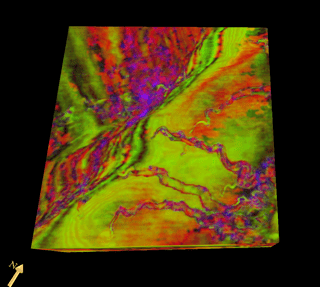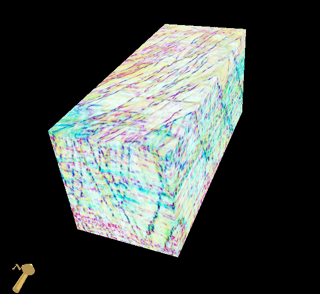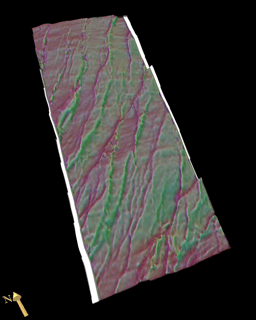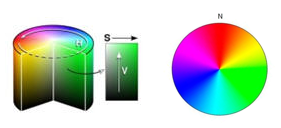GeoTeric offers two decomposition workflows – the High Definition FD (HDFD) and the Standard FD. In both workflows, the integrated use of RGB (Red, Green and Blue) blending to display the results allows for co-visualisation of up to 3 magnitude volumes to result in a richer image of the geology.
GeoTeric not only supports RGB blending but also CMY (Cyan, Magenta and Yellow) and HSV (Hue, Saturation and Value) which can be successfully applied to a variety of different attributes - not just the output from the Frequency Decomposition.
RGB
RGB can produce very informative cubes when blending attributes
such as the example below from the Taranaki basin, offshore New Zealand.
White = High response from all three input volumes
Black = Low to no response from all three input volumes
Colour = one or two of the input volume(s) has relatively higher response than the other(s)
 |
| Taranaki basin, offshore New Zealand |
R = Instantaneous Frequency
G = Envelope
B = Chaos
CMY
GeoTeric offers different Edge Attributes targeting varying fault responses. Combining 3 Edge attributes in a CMY blend result in visualising the complete fault expression from the data. The blend below also includes Dip indicating in yellow the high-dipping areas.
 |
| Data from Sybarrow NW offshore Australia |
C = Tensor
M = SO Semblance
Y = Dip
HSV
HSV blends work slightly differently in that the colour map used is “circular”- therefore it benefits from including an attribute which is circular in nature. In the example below an Azimuth volume has been included.
 |
| Data from Sybarrow NW offshore Australia |
Hue = Azimuth
Saturation= Dip
Value = Flexure
The positive Y axis of the volume/survey is the North direction which is highlighted by red.
The brighter, more vivid the colours in the blend indicates high response in the other two attributes - in this case Dip and Envelope.
The darker less colourful the colours are in the blend, the lower the response in the two attributes.
As we can see the blends give the user more information than a single attribute and the blends can in turn either be exported as segy or transferred into Petrel for further interpretation work.
If you are wanting to maintain the high resolution of GeoTeric’s RGB and CMY blends and if you are working in Petrel we strongly recommend using the Link for Petrel to transfer the blends across into Petrel. GeoTeric’s link for Petrel maintains the high resolution of the blend. It currently supports the transfer of RGB and CMY blends. Once the blends are in Petrel they can be visualised and to interpret further a seismic cube can be created. See this blog post for an example using a CMY blend.
If you export the blend as a segy, the maximum resolution you can maintain is 8bit so you will notice a considerable degradation in resolution.




